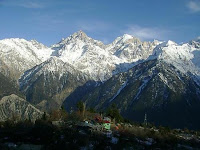 Shimla, was the Summer capital of India under British rule. Presently, it is the state capital of Himachal Pradesh, with its population around 1.6 lacs (Shimla town only). Shimla has seen many important historical events such as the famous Shimla Pact between India & Pakistan which was signed here. The place is also famous for its natural beauty, architectural buildings, wooden crafts and apples.(also known as Simla) is a tourist destination par excellence. It is a beautiful hill town in the lap of nature, surrounded by pine and deodar forests. Temperature is ideal in summers and tourists flock it in great numbers and it is highly advisable to get hotel reservations done well in advance despite the fact that there are over 1000 hotels in Shimla. It is well connected by road to the plains. Facilities and amenities are good. People are friendly. It is also comparatively safer than other tourist destinations. All this makes it the favorite travel destination of tourists from India and across the world. A amazingly high percentage of tourists come back here again.
Shimla, was the Summer capital of India under British rule. Presently, it is the state capital of Himachal Pradesh, with its population around 1.6 lacs (Shimla town only). Shimla has seen many important historical events such as the famous Shimla Pact between India & Pakistan which was signed here. The place is also famous for its natural beauty, architectural buildings, wooden crafts and apples.(also known as Simla) is a tourist destination par excellence. It is a beautiful hill town in the lap of nature, surrounded by pine and deodar forests. Temperature is ideal in summers and tourists flock it in great numbers and it is highly advisable to get hotel reservations done well in advance despite the fact that there are over 1000 hotels in Shimla. It is well connected by road to the plains. Facilities and amenities are good. People are friendly. It is also comparatively safer than other tourist destinations. All this makes it the favorite travel destination of tourists from India and across the world. A amazingly high percentage of tourists come back here again.5 Star Hotels in Shimla
Hotel Woodville Palace Shimla
The Oberoi Cecil Shimla India
Shilon Resort Shimla India
Hotel Radisson Shimla
Cecil Oberoi
Wildflower Hall Resort Shimla
4 Star Hotels in Shimla
Hotel Asia The Dawn Shimla
Hotel Springfields Shimla India
Hotel Honeymoon Inn Shimla India
Hotel Combermere Shimla India
Hotel East Bourne Shimla
Hotel Himdev Shimla
Hotel Pine View Shimla
Hotel The Chalets Shimla
3 Star Hotels in Shimla
Ashiana Regency Shimla
Baljees Regency Shimla
Hotel Barog Heights Shimla
Hotel Combermere Shimla
Hotel Himland East Shimla
Hotel Himland West Shimla
Hotel Gables Shimla
Honeymoon Inn Shimla
Koti Resorts Shimla
Moon International Shimla
Hotel Shingar Shimla
Star Resort Shimla
Hotel Surya Shimla
Hotel Victory Shimla
Hotel Whistling Pines Shimla
Willow Banks Shimla
Hotel Marina Shimla



























